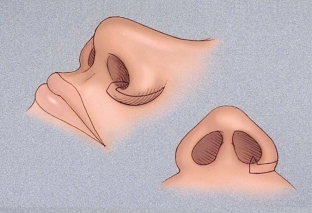Rhinoplasty is considered to be one of the most complex operations in plastic surgery, as it involves intervention on an organ that performs vital functions and has a rather complex structure. Like any other surgical intervention, rhinoplasty involves the development of possible complications, both during the surgical intervention itself and in the postoperative period. The high qualification of a plastic surgeon, a thorough knowledge of the anatomy of the nose and the techniques of the surgical intervention being performed, as well as knowledge of possible complications and ways to prevent them will help to avoid unpleasant consequences during rhinoplasty, as well as in the postoperative period.
Features of rhinoplasty that determine the complexity of surgical intervention
Rhinoplasty is one of the most technically complex operations in plastic surgery, as surgical intervention on the nose area has its own characteristics, such as:
- the nose area is an open area on the face and requires absolutely precise proportions during rhinoplasty;
- Nose structures are three-dimensional, axial symmetry must be strictly observed;
- the nose is a functionally important organ, damage to its functionally important structures must be avoided;
- the structural features of the nose are strictly individual for each person, in each individual case rhinoplasty requires a strictly individual approach;
- It is possible to assess the final result of rhinoplasty no earlier than in a year.
How do complications of rhinoplasty differ from unfavorable results of surgery
Plastic surgeons should distinguish between complications of rhinoplasty and an adverse outcome of the operation. Complications of rhinoplasty are usually called unexpected consequences of surgical intervention, the occurrence of which is theoretically possible to prevent. An unfavorable result of rhinoplasty is the expected consequences of surgery, which theoretically cannot be prevented. Complications and adverse results of rhinoplasty can be predicted and prevented to a lesser extent in accordance with the individual characteristics of the organism of each individual person. Nevertheless, the incidence of complications of rhinoplasty according to the latest data is 4-5% of all surgical interventions in the nasal area.

Classification of rhinoplasty complications: groups and subgroups
There are a large number of possible complications of rhinoplasty, in order to systematize them, all the complications of this surgical intervention were divided into groups and subgroups:
- complications by time of occurrence: intraoperative, early and late postoperative;
- by meaning: general and local complications;
- by the nature of the complications: anatomical, functional and psychological;
- by specificity: aesthetic and non-aesthetic;
- by prognostic sign: expected and unexpected;
- by manifestations: infectious, traumatic, hemorrhagic and various.
What factors will help prevent the development of rhinoplasty complications
The occurrence of rhinoplasty complications depends, first of all, on the competence of the operating surgeon. Accurate knowledge of the anatomy of the nose, a well-developed aesthetic sense, adherence to clear recommendations and the use of only proven rhinoplasty techniques, as well as taking into account all the individual characteristics of the body of each individual patient, will help prevent the occurrence of complications of rhinoplasty. At the same time, the patient's strict adherence to all the recommendations of a plastic surgeon also plays a role in preventing the development of postoperative complications of surgery, especially late ones. In any case, revision rhinoplasty should always be considered if there is an indication for such an operation.







Add a comment